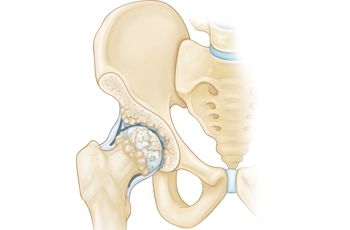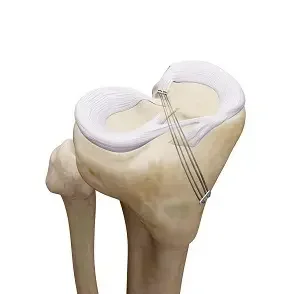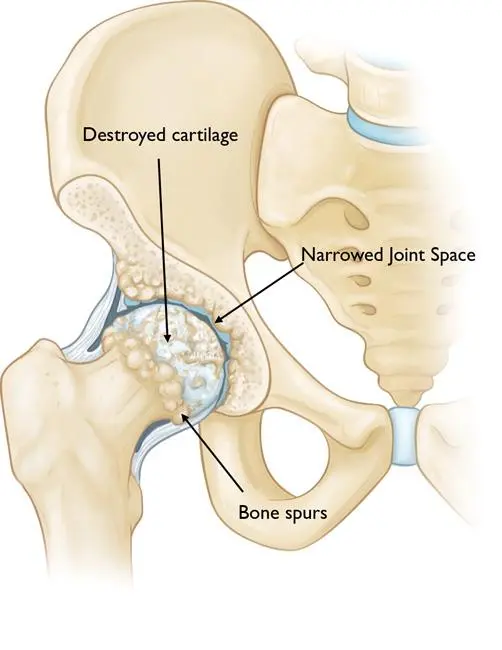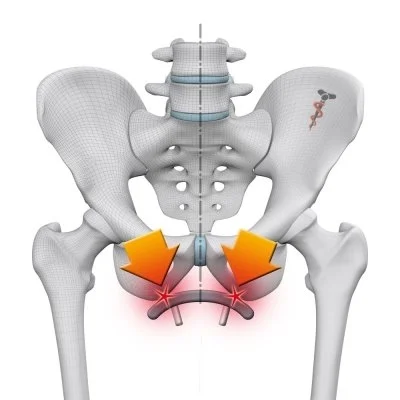Tips for a Speedy and Successful Hip Replacement Surgery Recovery
Introduction:
Hip replacement surgery, also known as hip arthroplasty, is a common and highly effective procedure that can transform the lives of individuals suffering from debilitating hip pain and reduced mobility. This surgical intervention replaces a damaged or deteriorated hip joint with a prosthetic implant, aiming to restore function, alleviate discomfort, and enhance overall quality of life.
However, the road to complete recovery following a hip replacement is a journey that requires patience, dedication, and a clear understanding of the various stages involved. In this comprehensive guide, we will explore the hip replacement surgery recovery timeline, shedding light on the critical milestones, challenges, and strategies that can help you achieve a successful rehabilitation process.
Whether you are contemplating hip replacement or have recently undergone the procedure, this article will serve as an invaluable resource to help you navigate the path to a more comfortable, active, and pain-free life.
Replacement of the Hip Joint procedures
Total hip joint replacement can in a variety of forms, including:
- Cemented hip replacement: In this type of hip replacement, the artificial joint components are attached to the residual bone
- Using a particular bone cement. When older people or those bones are involved, a cemented hip replacement is frequently done.
- Uncemented hip replacement: The artificial joint parts of an uncemented hip replacement are made to adhere directly to the
- Bone without the use of cement. Younger patients or those with bones are frequently candidates for this type of hip replacement strong.
- Hybrid hip replacement: In a hybrid hip replacement, both cemented and uncemented components are used during the same procedure. For instance, the acetabular cup may be cemented while the femoral stem is not.
- Metal-on-polyethylene: During this style of hip replacement, the artificial joint’s ball is composed of metal, while the socket is constructed of a plastic material called polyethylene. The most popular hip joint replacement is this one.
- Ceramic-on-polyethylene: The ball portion of the artificial joint is composed of ceramic, similar to metal-on-polyethylene, and the socket portion is made of polyethylene. Hip replacements made of ceramic instead of metal or polyethylene may be more fragile and prone to fracture. Hip replacements made of polyethylene might have lower wear rates.
- Metal-on-metal: Both the ball and socket parts of a metal-on-metal hip replacement are comprised of metal. Nowadays, this kind of hip replacement is less frequent because of worries about side effects. negatively impacting the body by releasing metals
The patient’s age, bone quality, and other criteria will all be taken into consideration when deciding which type of hip replacement to utilize.
Exercise level and any underlying medical conditions. The ideal hip for your particular circumstance will be discussed by your orthopedic specialist.
Operative techniques:
For a total hip replacement, a number of surgical techniques can be performed, involving:
- Anterior Approach: To be able to access the hip joint using this technique, the surgeon creates a small incision at the front of the hip. This strategy is improving in terms of pain relief and recuperation. popular because of the potential for quicker and less severe muscle damage.
- Posterior Approach: For it to reach the joint, this method entails making an incision at the back of the hip joint and repositioning muscles. The old method of performing hip replacement surgery is still widely employed today.
- Lateral Approach: When attempting to access the hip joint using this technique, the surgeon makes an incision on the side of the hip. Less frequently than the front or posterior route is the lateral approach.
- Direct Lateral Approach: When trying to access the hip joint with this technique, the surgeon creates an incision on the side of the hip and cuts through the muscles. Due to the possibility of muscle damage and the required recuperation time, this strategy has been less popular in recent years.
The surgeon’s inclination and expertise, the patient’s anatomy, and any pre-existing medical issues may all influence the surgical method that is chosen. Before having hip replacement surgery, it’s crucial to talk about the potential risks and benefits of the technique with your surgeon.
Complete hip replacement indications:
A total replacement of the hip is often advised for people with severe hip pain and reduced movement as a result of problems like:
- Hip Osteoarthritis: Perhaps the most frequent reason for complete hip replacement is this. A degenerative joint disease called osteoarthritis causes the cartilage in the hip joint to wear down, resulting in painful bone-on-bone contact.
- Rheumatoid arthritis: The synovial lining of the joint becomes inflamed as a result of this chronic autoimmune condition. In extreme situations, it can cause the bones and cartilage to erode, causing excruciating agony and incapacity.
- Avascular necrosis: During this disorder, the blood supply to the hip joint is obstructed, which causes bone loss and joint collapse.
- Hip fractures: Trauma from a fall or a car accident can result in hip joint fractures. Surgery can be necessary in some circumstances to replace the injured joint.
- Developmental dysplasia of the hip: In this problem, the hip joint doesn’t grow properly, which causes instability and joint wear and tear.
- Congenital hip deformities: Hip joint deformities brought on by specific congenital disorders may necessitate surgical correction.
This is crucial to remember that not every hip pain condition needs a total hip replacement. Your medical professional will assess your situation and decide if this operation is the best course of action for you. Before recommending a total hip replacement, other treatment alternatives, such as medication and minimally invasive physical therapies, may be suggested.
Total hip replacement surgery aims to treat pain from hip-related injuries and diseases, including osteoarthritis and rheumatoid arthritis, and to restore the range of motion in your joint. Steps in the hip joint replacement operation:
The day following the procedure
- The time has come to start moving that new hip joint.
- You’ll learn exercises from a physical therapist to build your surrounding muscles’ strength.
- You’ll likely step out of your bed, get up, and begin to walk. You might even begin physical therapy if your operation was early in the day and went well.
The afternoon of your operation for therapy.
1-2 Days Following
- Instead of taking medicines, you’ll undertake more exercise and walk with crutches.
- The liquid-only diet you had on the first day should be replaced with the ability to eat regular foods. a walker, etc. You’ll probably transition from IV pain when your pain decreases.
2-3 Days Following
- Moving around ought should be simpler now.
- It’s time to return home if everything is going nicely.
- Make sure you have support arranged for errands and other tasks like shopping.
- For three to six weeks, you won’t be allowed to drive.
- You are able to go to a treatment facility if you require further assistance. Alternatively, make plans for a home health aide to spend a few days with you.
4 Days and Further
- Treat the area around your incision with care.
- Avoid using creams, lotions, and ointments, and avoid getting it wet.
- Applying an icepack to the area for 10 to 15 minutes at a time can reduce pain.
- Maintain movement in the joint and perform the exercises you learned at the hospital.
- A home health nurse or a physical therapist might pay you a visit.
10-14 days
- A person should be able to move around more freely without assistance for up to two weeks following a full or partial hip replacement.
- Before surgery, patients who had previously needed a cane or walker would still require one during the initial stages of recuperation.
Next two weeks,
- A person can typically resume light daily activities within three to six weeks.
- They might have greater strength and ease when supporting some weight with their leg.
- A person might be able to pick up some simple self-care and easy tasks during this period.
In addition to 2–3 months
- A person may be able to resume daily activities after two to three months following partial or total hip replacement, but they should still engage in daily physical therapy and frequent walking.
More than three months
- You might reach the point where you can fully resume your daily activities, including a few low-impact sports, after three months.
- If you can probably get around without much help, it’s still important to keep up your physical activity.
- It’s still crucial to continue your physical therapy exercises and to regularly engage in modest movement and light walking.
As advised by their physical therapist, a person should continue physical treatment twice daily, go for regular walks, and refrain from spending too much time sitting down.
Exercise can improve mobility and help with pain relief and stiffness. The improvement of function and return to regular daily activities are the main goals of this phase.
The patient will work with the physiotherapist to do tasks like climbing stairs, getting in and out of a car, going to work, or participating in sports. To keep their hip joints healthy, the patient will keep doing strengthening and conditioning workouts and perform.
It’s crucial to remember that these stages are flexible and may change based on the patient’s development and specific needs. needs. To get the best outcome for the patient, the physiotherapist will adjust the treatment plan accordingly.
By this time, discomfort and stiffness should have subsided, so a person can work on enhancing the hip’s following functions:
- Power
- Flexibility
- Motion
This can be accomplished by engaging in light workouts that emphasize good posture, weight-bearing, and body movement. There may still be some weakness in the muscles surrounding the hip.
Quickly Following Surgery Recovery:
Patients must spend a few days in the hospital after surgery.
workouts to aid in their healing. Doctors may advise patients to use a spirometer, a tool that aids in preventing pneumonia. You inhale deeply while keeping an eye on your breathing. They will learn and acclimatize to their new hip throughout this period.
Within a day of surgery, basic physical therapy exercises like using a walker normally start. Prior to leaving the rehabilitation facility or their home, patients are taught strengthening exercises. They can recover their strength and mobility at a hospital.
Typical conservative therapies for problems with the hip joint include:
- Medicine for pain,
- Therapeutic exercise
- Weight loss
- Physical Therapy
- Frequent stretching
- Walkers’ aids, such as a cane
What will the healing period consist of?
Although every person recovers differently from a total hip replacement, there are certain typical milestones. This data set was obtained from numerous patients who had this procedure. Several days following surgery, you’ll likely be released and sent home or to a rehab facility. You’ll require someone to assist you for a few days to a few weeks.
A physical therapist will work with you on doing particular exercises and movements while you’re in the hospital recovering from your operation.
Following hip replacement surgery, physical therapy helps to increase blood flow and strengthen muscles. Additionally, it enables you to start moving safely.
A physical therapist will work with you soon after your operation to assist you:
- Get out of bed.
- Rise from the bed
- Short distances comfortably while using crutches or a walker
- Additionally, your physical therapist will assist you in performing targeted strengthening and range-of-motion exercises while you are in bed.
A physical therapist will give you instructions on daily exercises that you should perform at home before you leave the hospital. They will provide you with advice regarding how much weight you should put on while sleeping, sitting, or bending.
You’ll find it simpler to carry out your everyday tasks as you grow stronger and are able to bear greater weight on your leg. You’ll probably require less assistance than before to perform certain simple tasks and take care of yourself. It usually takes 4 to 6 weeks to start feeling stronger and able to move around with less pain.
It will still be necessary to keep up with physical treatment by showing up for appointments. At this point, walking is particularly crucial to your recuperation. Walking on a regular basis and limiting your sitting time are also recommended. They will work with you to ensure that you continue to raise your.
- Power
- Flexibility
- Joint motion
- Equilibrium
- Exercises that emphasize weight-bearing, good posture, and body mechanics are particularly beneficial, especially for older persons who are more susceptible to falling.
Because every person is unique, see your doctor or physical therapist to assess your situation. They can provide you with advice on the kinds of workouts you should be performing based on your development.
combine physical therapy and exercise:
Osteoarthritis can be prevented and its progression is slowed with exercise.
Exercise helps you control your weight while also enhancing your strength, flexibility, and mobility. Exercises with low impact are less likely to strain a hurt joint. Tai chi is highly advised for those with hip problems by experts in osteoarthritis Participating in physical therapy might be painful.
A healthy recovery requires daily physical activity and exercise, starting the day following your procedure. Setting up a reliable routine is essential.
After surgery, a physical therapist can suggest strengthening and mobility drills. These will raise blood circulation. strengthen the muscles in the area around your new hip. Additionally, they will lessen the amount of scar tissue and increase the range of motion in your new hip.
It’s possible that you’ll feel some pain while in therapy.
People may think about the following options to lessen pain:
- Taking painkillers about 30 minutes prior to treatment
- Applying a warm compress before treatment to help the joint loosen
- After therapy, apply a cold compress to minimize swelling
- A physical therapist or doctor should be notified right away if your pain is severe and/or getting worse. Stretching and flexibility:.
These benefits can be obtained if you regularly exercise:
The advantages of regularly exercising are as follows,
- Improved muscular strength
- Enhances everyday activity performance
- Enhanced Motion Range
- lessen inflammatory
- Boost your balance or posture.
- Muscles are relaxed.
- Reduce discomfort,
- Enhance motion,
- Increase flexibility
- Greater physical fitness
Guidelines to Complete Hip Replacement Exercises:
For a full recovery following a total hip replacement, regular exercise to regain hip strength and mobility as well as a gradual return to daily activities are crucial.
Your physical therapist and orthopedic surgeon could advise you to exercise for 20 to 30 minutes every day, or even twice or three times a day in the early stages of rehabilitation. They might recommend a few of the workouts listed below.
Before attempting any of the activities demonstrated, be sure to consult your therapist or surgeon to guarantee your safe recovery
- Turn on by seeking advice and recommendations from a physical therapist.
- Practice all stretches carefully, and increase flexibility gradually.
- Stop if you feel pain.
- Increase intensity slowly.
- Increase the amount of time you spend on an activity if you don’t experience pain after the first few days.
- Although it may be difficult to stretch very far at first, with practice, your flexibility will improve
Postoperative Exercises
As soon as you are able, begin the workouts. They can be started right after surgery in the recovery area. These exercises may seem awkward at first, but they will speed up your healing and even lessen your postoperative pain.
lying down position exercises:
Hamstring Band Stretch
- Place your back on the yoga mat.
- Raise one leg off the mat, keeping the knee slightly bent.
- Wrap a resistance band around the sole of the outstretched leg’s foot.
- Pull the leg in as far as it will go towards your chest comfortably.
- Maintain this posture for a few seconds.
- Return to your neutral position after that.
- Then unwind.
- Rep with the opposite leg.
- 5-10 times through this exercise.

Ankle Rotations
- You may perform ankle circles while sitting or lying down.
- Starting with the left, slowly turn your ankle to the left, then to the right.
- With your foot in the air, you might find it simpler to draw the letters.
- Put your big toe in front.
- Use only your foot and ankle, not your entire leg, and keep your movements small.
- Then take a position that is neutral.
- Then unwind.
- Repeat 5- 10 times per day.
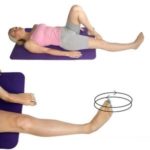
Buttock Contractions
- Your buttock muscles should contract as you hold for five counts.
- Hold it there for a short while.
- Slowly revert to your starting position.
- Then unwind.
- Repeat 5- 10 times per day.
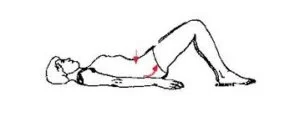
Abduction Exercise
- Stack your hips as you lay on your side.
- To support your head, fold the arm that is closest to the floor under you.
- As a reminder to yourself not to slant forward or backward, place your upper hand on the ground in front of you Flex and stack both feet.
- When you feel your hip flex, lift your top leg up just over your hip.
- Hold it there for a short while.
- Slowly revert to your starting position.
- Then unwind.
- Repeat 5- 10 times per day.
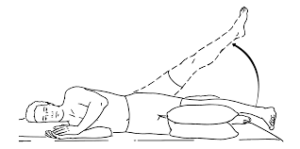
Straight Leg Raises
- Beginning by lying down on a table or the floor in a relaxed position.
- Now stoop down on one knee.
- Next, raise your entire leg slowly.
- While maintaining the other knee in place.
- Hold for a short while after that.
- Next, extend your leg.
- Slowly revert to your neutral stance.
- Then unwind.
- On the opposite side, repeat.
- Repeat 5-10 times on each side.

Standing Exercises:
You will be able to get out of bed and stand up shortly after your surgery. You will first need assistance, but when your strength returns, you will be able to stand on your own. Be sure to grip onto a solid surface when performing these standing exercises,
Standing Knee Raises
- To provide support, place one hand on the back of a chair.
- Inhale as you stand side-on with your feet touching.
- Exhale, then slowly lift one knee off the floor.
- Maintain a straight back while looking ahead.
- Hold for a little while.
- Inhale deeply and bring your leg back to the beginning position gradually.
- Then take a neutral posture.
- Then unwind.
- Move on to the opposite leg.
- Five to ten times should be done the activity.
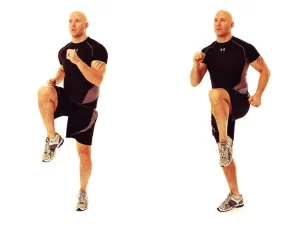
Standing Hip Abduction
- Place a table or chair next to you and stand with your legs shoulder-width apart to maintain stability.
- To protect your back, contract your abdominal muscles.
- Kick your leg out to the side of your body while keeping your knee straight and your toes pointed forward.
- Throughout the entire workout, be sure to maintain a straight upper body and back.
- Then take a neutral posture.
- Then unwind.
- Move on to the opposite leg.
- Five to ten times should be done the activity.
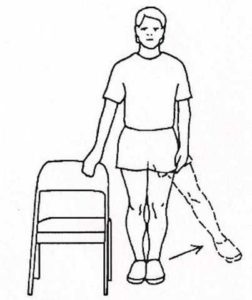
Standing Hip Extensions
- Put a table or chair next to you and stand with your legs shoulder-width apart to maintain stability.
- To protect your back, contract your abdominal muscles.
- Lift your affected leg slowly backward.
- Try to maintain a straight back.
- Hold for two to three counts.
- Then take a neutral posture.
- Then unwind.
- Move on to the opposite leg.
- Five to ten times should be done the activity.
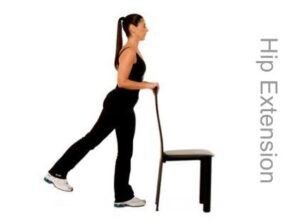
Preliminary Activity:
Soon after surgery, you can move about your hospital room for short distances and carry out simple daily tasks.
Exercise speeds up your recuperation and enables your hip to restore its strength and range of motion.
Walking:
The best technique to aid with your hip recovery is through proper walking. In the beginning, you’ll need a walker or crutches to get around. Your doctor or Your therapist will advise you on how much pressure to apply to your leg. Frequently go for walks Among the most effective strategies to speed up your recuperation is walking. For balance, you’ll initially use a walker and subsequently a cane.
You will begin by going for short walks of 5 to 10 minutes each, 3 or 4 times per day. The duration can then be increased to 20 to 30 minutes at a time, twice or three times per day as your strength increases. Following your recovery, a routine maintenance program should involve three or four times per week of 20 to 30-minute walks.
Stair Climbing and Descending:
Stair climbing is a great strength and endurance exercise that also involves flexibility.
- You will first require a railing for support and will be able to take only one step at a time. Always ascend the stairs with your good leg and descend with your operated limb. Remember the proverb “on top” with the beneficial, underneath the bad.”
- You may wish to have someone assist you with navigating stairs until you have regained the majority of your strength and mobility.
- Never attempt to ascend steps that are taller than the typical height (7 inches), and always utilize a railing for balance.
- As you gain strength and mobility, you can start climbing stairs foot by foot.
Advanced Exercises and Activities:
Your hip muscles have been weakened by the discomfort you had from your hip issues prior to surgery as well as the agony and swelling that followed. Additionally, because your hip didn’t fully recover after total hip replacement, the muscles around your hip grew short and tight.
It will take time for your muscles to rehabilitate and adjust to your new hip, which will take many months.
moves unhindered.
What amount of time does it take for the replacement of a hip to heal?
Everybody’s body reacts to hip replacement surgery differently. People typically need many months to fully recover completely.
For a few months, you’ll need physical treatment.
Your medical professional or therapist may recommend that you begin stretches and exercises as soon as 24 hours after your procedure. Your standing and sitting stability, flexibility, and hip and leg strength will all be under scrutiny.
The muscles that encircle your hip joint need to be stretched out and strengthened. You’ll begin gradually.
again bending, walking, and ascending stairs. Your strength and range of motion will gradually return. You may have to Before you may use your hip without any restrictions, wait six to twelve weeks.
After a hip replacement, restrict the following activities:
There are a few motions that you should never make within a few weeks of your surgery because they could cause your hip to dislocate.,
- Lifting your knee too high: The thigh should always be positioned lower. Your new hip joint may become worse if your hip is raised above a 90-degree level.
- Trying to rotate your toes inward: Your hip may also rotate inward if you try to move your toes inward. Keep your toes pointed outward or straight at all times.
- One of the most typical actions that everyone takes is crossing their legs. Therefore, a wedge pillow will be given to you to help you avoid this issue.
Alternatives and Care:
Although hip replacement surgery is the best option, there are other options. Alternate therapies like partial hip replacement(hemiarthroplasty) or hip resurfacing may also be taken into consideration depending on the patient’s health and preferences.
The most appropriate procedure can be determined by speaking with hip replacement doctors in your area based on the patient’s choice.
Exercises for hip replacements are essential to the recovery process. Physical therapy sessions aim to increase joint function overall, strengthen the muscles around the affected area, and enhance the range of motion. These exercises are suited to each person’s needs and are essential to the rehabilitation process.
Summary:
In conclusion, recovering from hip replacement surgery is a significant and rewarding endeavor. The path to improved mobility, reduced pain, and enhanced quality of life requires dedication and understanding of the recovery timeline. With the right information and commitment, you can navigate this journey successfully. Remember that every individual’s experience may vary, but armed with knowledge and perseverance, you can look forward to a future with increased comfort and greater mobility.
FAQs
What does a hip replacement consist of?
Hip replacement surgery, also known as total hip arthroplasty, is a medical procedure in which a damaged or diseased hip joint is replaced with an artificial joint known as a prosthesis. The goal of the surgery is to make the hip joint less painful, more mobile, and more functional.
Who requires a hip replacement?
People who suffer from osteoarthritis, rheumatoid arthritis, avascular necrosis, fractures, or other hip joint ailments are candidates for hip replacement surgery.
Which advantages come with having a hip replaced?
In addition to providing pain relief and increased mobility, hip replacement surgery also improves quality of life. It lessens or completely eliminates hip discomfort, restores mobility and range of motion, and makes it more comfortable for people to take part in recreational activities.
What kind of time may recovery from a hip replacement procedure take?
Each person recovers from hip replacement surgery at a different pace. Typically, it takes 6 to 12 weeks for recovery to reach the point at which people can return to their regular lives. However, it can take a few months to fully recover your mobility.
For how long is bed rest required following hip replacement?
Your care team will often try to get you up and moving the day of your surgery or the day after. following 10–12 weeks of daily physical therapy exercises, you ought to be ready to resume the majority of your regular activities. However, a total hip replacement recovery period lasts six to twelve months.
What are the top 3 mistakes to avoid following hip replacement surgery?
When sitting or standing, avoid leaning forward and avoid bending past 90 degrees (the angle formed by the letter “L”).
Never raise your knee above your hip.
Avoid sitting on beds, low chairs, or toilets.
After a hip replacement, is it possible to climb stairs?
Following the treatment and for the first few weeks of recovery, you will need assistance ascending or descending stairs, such as by using the handrails and a cane. You should add handrails or banisters on your stairs at home.
What cannot be done following hip surgery?
After surgery, you shouldn’t bend your hip more than 60 to 90 degrees for the first six to twelve weeks. It’s crucial that you avoid crossing your legs or ankles. It’s better to avoid bending down to pick items up during this period.
What sort of physical rehabilitation is necessary following a hip replacement?
Physical therapy following a hip replacement seeks to enhance balance, control pain, strengthen muscles, and promote recovery. Exercises, gait training, and strategies may be included in the program, which is tailored to each individual. The patient’s progress determines the length and level of therapy.
How can one recover from a hip replacement the quickest?
Consider getting off of work for yourself.
With light exercise, relaxation and recuperation can be balanced.
Think about your diet to hasten your recuperation.
When lying in bed, pay attention to your hip.
Which kind of activity is most beneficial following a total hip replacement?
Patients respond differently to workouts in terms of effectiveness. However, most experts agree that the best activity after complete hip replacement is walking. This is due to the activity’s low-impact nature and ability to encourage hip movement.
How can I make my hips stronger after a hip replacement?
Walking
Standing hip abduction
Standing hip extension
Bed-Supported Knee Bends
Straight leg raises
So after a hip replacement can you fully bear weight on the leg?
Right away, you should feel confident using a cane or no aid at all while walking while standing entirely on the treated leg.
References
- Hip Surgery Recovery Timeline. n.d. WebMD. https://www.webmd.com/osteoarthritis/ss/slideshow-hip-surgery-recovery- timeline. In-Text Citation: (“Hip Surgery Recovery Timeline,” n.d.)
- Geng, C. 2022, October 5. The healing process after a hip replacement. https://www.medicalnewstoday.com/articles/hip- replacement-2. In-Text Citation: (Geng, 2022)
- Hecht, M. 2021, January 20. What Helps with Hip Replacement Recovery? Healthline. https://www.healthline.com/health/hip- replacement-recovery. In-Text Citation: (Hecht, 2021)
- Professional, C. C. M. n.d. Hip Replacement (Hip Arthroplasty). Cleveland Clinic. https://my.clevelandclinic.org/health/treatments/17102-hip-replacement. In-Text Citation: (Professional, n.d.)
- AAOS’s OrthoInfo website offers a total hip replacement exercise guide. 2022, February 1. Total Hip Replacement Exercise Guide – OrthoInfo AAOS.https://www.orthoinfo.org/en/recovery/total-hip-replacement-exercise-guide/. In-Text Citation: (“Total Hip Replacement Exercise Guide – OrthoInfo – AAOS,” 2022)



